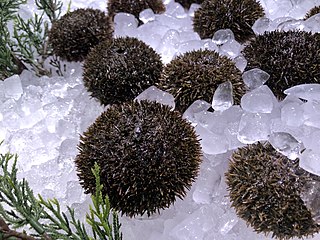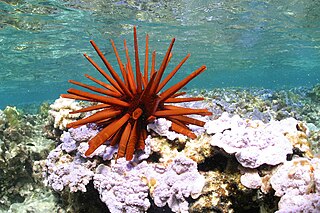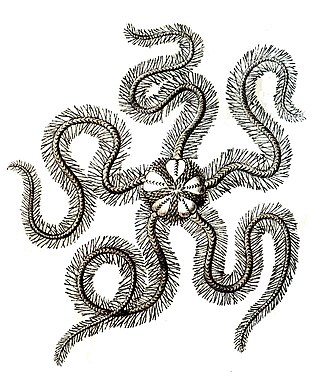
Sea urchins or urchins are typically spiny, globular animals, echinoderms in the class Echinoidea. About 950 species live on the seabed, inhabiting all oceans and depth zones from the intertidal to 5,000 metres. Their tests are round and spiny, typically from 3 to 10 cm across. Sea urchins move slowly, crawling with their tube feet, and sometimes pushing themselves with their spines. They feed primarily on algae but also eat slow-moving or sessile animals. Their predators include sea otters, starfish, wolf eels, and triggerfish.

Echinus esculentus, the European edible sea urchin or common sea urchin, is a species of marine invertebrate in the Echinidae family. It is found in coastal areas of western Europe down to a depth of 1,200 m (3,900 ft). It is considered "Near threatened" in the IUCN Red List of Threatened Species.

Culcita schmideliana, commonly known as the spiny cushion star, is a species of pin-cushion star. It has a variety of base colors and often patches of a different color. It is pentagonal in shape and lives in the tropical Indo-Pacific. This species is rarely kept by hobby aquarists.

Hemicentrotus pulcherrimus is a species of sea urchin, the only one in the monotypic genus Hemicentrotus. It was first described by the American engineer and marine zoologist Alexander Agassiz in 1864 as Psammechinus pulcherrimus. Its range extends along the coasts of Korea, Taiwan and China, and in Japan from Kyūshū to Ishikari Bay. An edible species, it is harvested from Kyūshū to Fukui, in the Sea of Japan.

Heterocentrotus mamillatus, commonly known as the slate pencil urchin, red slate pencil urchin, or red pencil urchin, is a species of tropical sea urchin from the Indo-Pacific region.

Dendraster excentricus, also known as the eccentric sand dollar, sea-cake, biscuit-urchin, western sand dollar, or Pacific sand dollar, is a species of sand dollar in the family Dendrasteridae. It is a flattened, burrowing sea urchin found in the north-eastern Pacific Ocean from Alaska to Baja California.

The Camarodonta are an order of globular sea urchins in the class Echinoidea. The fossil record shows that camarodonts have been in existence since the Lower Cretaceous.

Psychocidaridae is a family of sea urchins in the order Cidaroida. The genus Psychocidaris is extant while the other genera are only known from fossils. The family has been in existence since the Lower Jurassic (Toarcian) and the range includes Europe, Ukraine, North America, North Africa and the West Pacific.

Sterechinus is a genus of sea urchins in the family Echinidae. All living members of the genus are found in the waters around Antarctica but the first species described in the genus was a fossil and was found in Europe.
Aspidodiadema jacobyi is a small sea urchin in the family Aspidodiadematidae. It lives in tropical seas at great depths. Aspidodiadema jacobyi was first scientifically described in 1880 by Alexander Emanuel Agassiz, an American scientist.

Asthenosoma varium is a sea urchin. Growing up to 25 cm (10 in) in diameter, it lives on sand and rubble sea bottoms in the Indo-Pacific, from the Red Sea to Australia and Southern Japan. Its venom tipped spines, with distinctive globular swellings below the tip, can inflict a painful sting if handled; the pain lasts as long as several hours. This capacity, perhaps coupled with its reddish-brown colour, has given it the common name fire urchin; other commonly used names are Pacific fire urchin, elusive sea urchin, variable fire urchin, and electric sea urchin.

The Echinometridae are a family of sea urchins in the class Echinoidea.
Pelanechinus is an extinct genus of sea urchins in the order Echinothurioida. It is placed in the family Pelanechinidae and is in the stem group of echinoids.

Eucidaris is a genus of cidaroid sea urchins known as slate pencil urchins. They are characterised by a moderately thick test, a usually monocyclic apical disc, perforate and non-crenulate tubercles and nearly straight ambulacra with horizontal pore pairs. The primary spines are few and widely spaced, stout with blunt flat tips and beaded ornamentation and the secondary spines are short and apressed. They originated in the Miocene and extant members of the genus are found in the tropical Indo-Pacific Ocean, East Pacific, Atlantic Ocean and Caribbean Sea.

Ossicles are small calcareous elements embedded in the dermis of the body wall of echinoderms. They form part of the endoskeleton and provide rigidity and protection. They are found in different forms and arrangements in sea urchins, starfish, brittle stars, sea cucumbers, and crinoids. The ossicles and spines are the only parts of the animal likely to be fossilized after an echinoderm dies.

Pseudocentrotus depressus, commonly known as the pink sea urchin, is a species of sea urchin, one of only two species in the genus Pseudocentrotus. It was first described in 1864 by the American marine zoologist Alexander Agassiz as Toxocidaris depressus, having been collected during the North Pacific Exploring and Surveying Expedition undertaken by Captain Cadwalader Ringgold and later Captain John Rodgers.

Clypeaster reticulatus, the reticulated sea biscuit, is a species of sea urchin in the family Clypeasteridae. This species was first scientifically described in 1758 by Carl Linnaeus. It lives on the sandy seabed of shallow seas, semi-immersed in the sediment.

Tetrapygus is a genus of sea urchins in the family Arbaciidae. It is a monotypic genus and the only species is Tetrapygus niger which was first described by the Chilean naturalist Juan Ignacio Molina in 1782. It is found in the southeastern Pacific Ocean on the coasts of South America.

Aspidodiadema is a genus of echinoderms belonging to the family Aspidodiadematidae. The species of this genus are found in the Indo-Pacific and Caribbean.

Pourtalesia miranda, commonly known as the wonderful sea urchin, is a species of sea urchin in the family Pourtalesiidae. It is found at abyssal depths in the Atlantic Ocean.

























